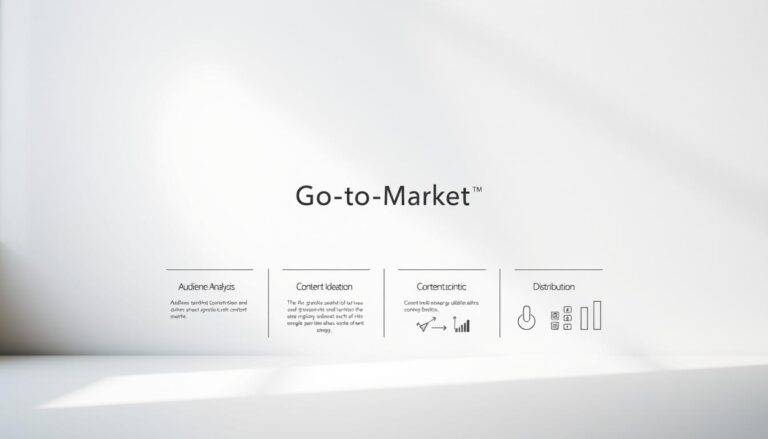Predictive analytics is now a key part of data-driven marketing. It helps businesses improve their work, streamline operations, and connect better with customers. The predictive analytics market is growing fast. It’s expected to jump from USD 10.5 billion in 2021 to USD 28.1 billion by 2026, MarketsandMarkets reports.
Today’s world is changing quickly, especially with tech advances. The COVID-19 pandemic, as McKinsey & Company note, has sped up these changes. Companies are reshaping their GTM strategies to stay ahead. Using predictive analytics, businesses can guess market trends, know what customers want, and spot possible hurdles. This makes marketing smoother and keeps it in step with the latest insights.
Key Takeaways
- Predictive analytics can significantly enhance decision-making in GTM strategies.
- Integrating predictive analytics in marketing automation leads to more targeted campaigns.
- Businesses using predictive analytics experience improved operational efficiency.
- The predictive analytics market is projected to grow substantially in the coming years.
- Real-time data insights from predictive analytics streamline GTM efforts.
- COVID-19 has accelerated the need for transformative GTM automation strategies.
- Understanding customer behaviors is crucial for successful marketing campaigns.
Understanding Predictive Analytics in GTM Automation
Predictive analytics is changing how businesses understand data. It uses stats and machine learning to guess the future from past information. By adding it to GTM automation, companies can guess how customers will act. This helps them make their marketing better and use their resources more wisely.
Being ahead in understanding market trends boosts a company’s position against others. This is the advantage of predictive analytics.
What is Predictive Analytics?
Predictive analytics uses data to make forecasts and insights. It includes tools that help businesses predict how customers will interact. This helps businesses improve greatly.
Businesses using predictive analytics see a big rise in how well they guess future trends. This leads to doing better than others. Staying updated with data helps companies lead in competitive markets.
The Role of Data in Predictive Analytics
Data is critical in making predictions. Good and accurate data makes the predictions reliable. If the data isn’t good, the insights won’t be either.
Companies moving to better analytics need to focus on getting diverse and accurate data. This makes the predictions better. Learning from insights shows how big firms like Netflix use data to keep viewers interested. This shows the big impact of good analytics.
Key Benefits of Predictive Analytics for GTM Automation
Predictive analytics in GTM automation brings many advantages, changing how businesses operate. Companies using these insights become more effective and efficient. They improve in many parts of their strategy.
Enhanced Decision-Making
Predictive analytics greatly improves decision-making. Teams can spot trends early with data insights. This helps make better strategic choices and act quickly. Using GTM automation and predictive tools boosts strategy success.
Improved Customer Targeting
With predictive analytics, targeting customers becomes more accurate. Analyzing customer behavior helps create tailored marketing. This makes messages more personal and boosts sales. Predictive analytics give companies an edge in getting and keeping customers.
Operational Efficiency
Operational efficiency is much better with predictive analytics. It makes repetitive tasks easier, saving time on manual work. This boosts productivity and saves money, leading to better results.

Learn more about predicting sales and boosting business at this resource. Using predictive analytics in GTM strategies leads to top-notch performance and growth in today’s market.
Integrating Predictive Analytics into GTM Strategies
Putting predictive analytics into GTM strategies means following a step-by-step plan. Doing this is crucial for companies wanting to get better results through smart decisions. They need to carefully adopt predictive analytics in their GTM tools to meet their specific goals.
Steps to Implementation
The first step is looking at the company’s current data and tech situation. By understanding what they already have, companies can better use predictive analytics. It’s important to set clear goals, as they direct the strategy to improve things like sales or customer interaction.
Here are the vital steps:
- Checking the quality and availability of data.
- Making goals that match the company’s aims.
- Sorting and fixing data to make sure it’s right.
- Keeping an eye on how the integration is doing.
Tools and Technologies
There are many tools out there for GTM automation using predictive analytics. Picking the right ones is key to success. For example, Salesforce Einstein offers advanced options for predictive modeling. Other important options are IBM Watson and Oracle Analytics, which help make GTM strategies work better.
Challenges in Leveraging Predictive Analytics
Organizations often struggle when adding predictive analytics into their GTM automation. These challenges can make strategies less effective and hurt business performance. Figuring out the main problems is crucial for success.
Data Quality Issues
Data quality is a big hurdle in GTM automation. Predictive models need accurate and full data to work well. Bad, old, or missing data can cause wrong insights and bad decisions. To fix this, a strong data governance strategy is needed.
This strategy should include checking data regularly, cleaning it, and keeping datasets of high quality. Doing so makes predictive analyses more reliable.
Resistance to Change
Resistance to change can block the use of predictive analytics. Employees used to old ways may struggle with data-driven decisions. It’s crucial to work past this resistance for success.
Helping employees switch includes giving them full training, involving them in the process, and showing the real benefits of predictive analytics. These steps can make teams and the whole organization better.

| Challenge | Impact on Implementation | Mitigation Strategies |
|---|---|---|
| Data Quality Issues | Poor insights and decision-making | Regular audits and data governance |
| Resistance to Change | Lack of adoption of new practices | Comprehensive training and stakeholder engagement |
Case Studies: Successful GTM Automation with Predictive Analytics
Many businesses are seeing great results with predictive analytics in GTM automation. They use data to push their sales and marketing forward. This has led to more customers coming in and staying.
Industry Examples
ClariVoice is a prime example. They used AI to make their sales better. This doubled how much people engaged with them and increased sales by 25% in three months. SwiftCRM is another great example. They used AI to score leads faster. This made their process 80% faster and increased sales by 40%. These stories show how using smart data can make a big difference.
Measurable Outcomes
The success stories of ClariVoice and SwiftCRM show the power of predictive analytics. It makes businesses run smoother and target customers better. This isn’t just for now; it gives them an edge over competitors for years to come.
| Company | Implementation | Results |
|---|---|---|
| ClariVoice | AI-driven outbound sales sequences | Doubled engagement, 25% increase in close rates |
| SwiftCRM | AI-powered lead scoring tool | 80% reduction in lead qualification time, 40% increase in conversion rates |
Future Trends in GTM Automation and Predictive Analytics
The future of GTM automation is shaped by AI and machine learning. These techs are changing the game for businesses aiming to improve customer service and work more efficiently. Gartner reports a lot of B2B marketing leaders are investing more in AI for predictive analytics. This marks a significant change in marketing.
The Rise of AI and Machine Learning
AI and machine learning will change how companies understand data and insights. They allow for quick processing of huge data amounts. This leads to smarter decisions. Thanks to smart algorithms, businesses can predict market changes and adjust quickly. This keeps them ahead in a fast-changing world.
Evolving Customer Expectations
As tech gets better, customers want marketing that is more personal and quick. They want solutions made just for them and fast. Marketing teams need to keep improving their tactics to keep up. Using predictive analytics to see these shifts helps companies meet customer needs. This makes them more competitive.
FAQ
What is the importance of leveraging predictive analytics in GTM automation?
Using predictive analytics in GTM automation is crucial. It helps businesses predict trends and behaviors in the market. This improves marketing strategies and customer interactions with data insights.
How can businesses benefit from predictive analytics in marketing automation?
Predictive analytics boosts decision-making and personalizes customer campaigns. It also makes operations more efficient, increasing sales chances.
What are some effective tools for predictive analytics in GTM automation?
Tools like Salesforce Einstein and HubSpot are great for predictive analytics in GTM. They handle and analyze data for better strategic choices.
What are the best practices for integrating predictive analytics into GTM strategies?
Start by checking the current data setup and choosing the right analytics tools. Make sure the data is good and keep an eye on the strategies to make them better over time.
What challenges might businesses face when adopting predictive analytics?
Companies might deal with bad data and employees who prefer old ways. These issues can slow down moving to a data-focused approach.
Can you provide examples of companies successfully using predictive analytics in GTM automation?
ClariVoice and SwiftCRM are examples of success in GTM automation with predictive analytics. They used AI to get better at engaging customers and speeding up sales, showing how data can lead to real benefits.
What future trends should we expect in GTM automation related to predictive analytics?
We’ll see more AI and machine learning in the future as companies try to tailor customer experiences. They’ll change their strategies based on predictive data to meet changing customer needs.



